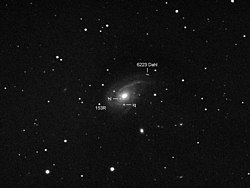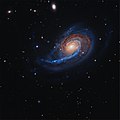| NGC 772 | |
|---|---|
 NGC 772 imaged by the Gemini Observatory [1] | |
| Observation data (J2000 epoch) | |
| Constellation | Aries |
| Right ascension | 01h 59m 19.5443s [2] |
| Declination | +19° 00′ 27.751″ [2] |
| Redshift | 0.008236 [2] |
| Heliocentric radial velocity | 2469 ± 2 km/s [2] |
| Distance | 105.7 ± 7.5 Mly (32.42 ± 2.29 Mpc) [2] |
| Apparent magnitude (V) | 11.1 [2] |
| Characteristics | |
| Type | SA(s)b [2] |
| Size | ~204,000 ly (62.56 kpc) (estimated) [2] |
| Apparent size (V) | 7.2′ × 4.3′ [2] |
| Other designations | |
| IRAS 01565+1845, Arp 78, UGC 1466, MCG +03-06-011, PGC 7525, CGCG 461-018 [2] | |
NGC 772 (also known as Arp 78 or the Fiddlehead Galaxy [3] ) is a large unbarred spiral galaxy approximately 106 million light-years away in the constellation Aries. It was discovered by German-British astronomer William Herschel on 29 November 1785. [4] [5]


